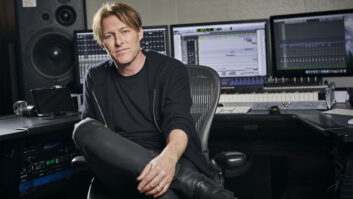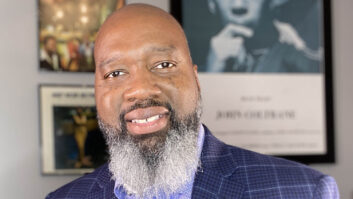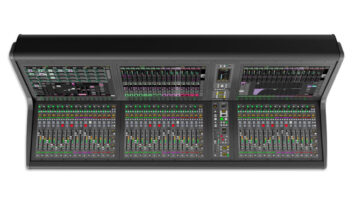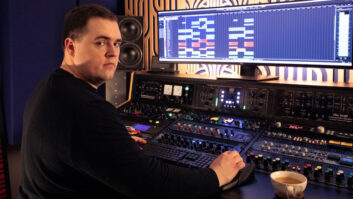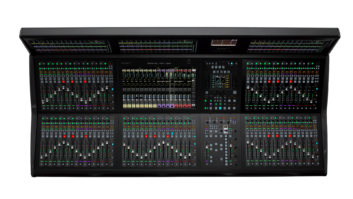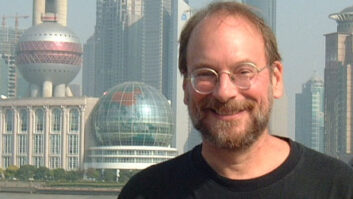There’s no pigeonholing composer/producer Tyler Bates. In the morning he might be working on composing music for Cirque Du Soleil’s first-ever live action thriller, R.U.N., set to debut at the Luxor in Las Vegas this November. And in the afternoon he may be writing with his co-producer Gavin Rossdale for the Bush album, due out early 2020. Or perhaps he’ll be working on the music for the second season of “Purge” for the USA Network, or composing music for a hot new video game.
One thing is certain, he won’t be resting on his laurels, basking in the glory of the music he scored for the recent box office hits John Wick: Chapter 3—Parabellum and Fast & Furious Presents: Hobbs & Shaw.
Seated in his home studio in Studio City, Calif., talking first about the importance of people and relationships, Bates is strikingly unpretentious.
In the studio, it’s all about trust, he says. The interpersonal connection is crucial and the process must be organic. He says while Marilyn Manson (with whom he co-wrote and produced two records) might be talking about his day, Bates could be composing something relevant to the topic.
“I make it so there are no stakes,” Bates says. “I mean, the only stake is finding that connection to why we began doing what we did, becoming who we are. There was no business to working with Manson. That was never a concern. It was a matter of, ‘Do we have a chemistry together that will allow for me to bring something out in him that is new, that will not only be interesting for his fans to get to know another dimension of who he is and the same for himself?’ The process I try to foster in the studio is a conversation that results in music.”
Bates lives for music, his passion evident since childhood. His mother, a huge music fan, had bona fide audio gear and turned him on to a smorgasbord of music—Coltrane, Joni Mitchell, Steely Dan, Kansas and Yes, among many, many others. Before he could read, his mother was reading liner notes to him, and he became curious about the production and the process.
He started off in school bands as an alto sax player, which he later realized provided immense value in his scoring work, but it was really when his mother got him a guitar at age 12 that the creative switch turned on.
“That was it,” Bates recalls, noting that as soon as he began playing guitar, he began to write and record. “I felt like I was able to communicate my thoughts and emotions very articulately. I was daisy-chaining cassette recorders together to multitrack, to make it more fun to play if I wasn’t playing to records.”
Right after high school, because of extenuating circumstances, Bates took a detour and worked in the options market in Chicago for a few years. Not for naught, he says, for it definitely provided him with a keen business acumen.
He returned to Los Angeles in the early ‘90s, painted houses and did whatever it took to keep himself alive while writing music, experimenting with different ways of recording, and diving into Tascam and Alesis ADAT recorders, which he says totally opened up his life.
Almost immediately after arriving in L.A., Bates was asked to score a low-budget film. At the same time, and in a manner that would repeat throughout his career, he formed the band Pet, which signed a deal with Atlantic Records. They toured for a while in support of their first album, which featured the track “Lil’ Boots.” That song was featured on the soundtrack album for The Crow 2—City of Angels, merging his musical worlds. Pet broke up soon after that one album, but the soundtrack went platinum, which inspired Bates to write songs for movies, as well as score them.
“I learned the craft of film scoring through directors, editors, producers, re-recording mixers, everyone else on a movie,” Bates says. “I had never met another composer until I had completed 18 movies, which is strange.”
His work in film and television scoring quickly flourished and by 2004 he scored Dawn of the Dead, where he says the Kurzweil K2500 opened up a new portal of experimentation of sound properties for him.
He says: “I thought, ‘Okay, let’s not pretend that we can scare people, because nothing scares me in a movie, so let’s make them uncomfortable.’”
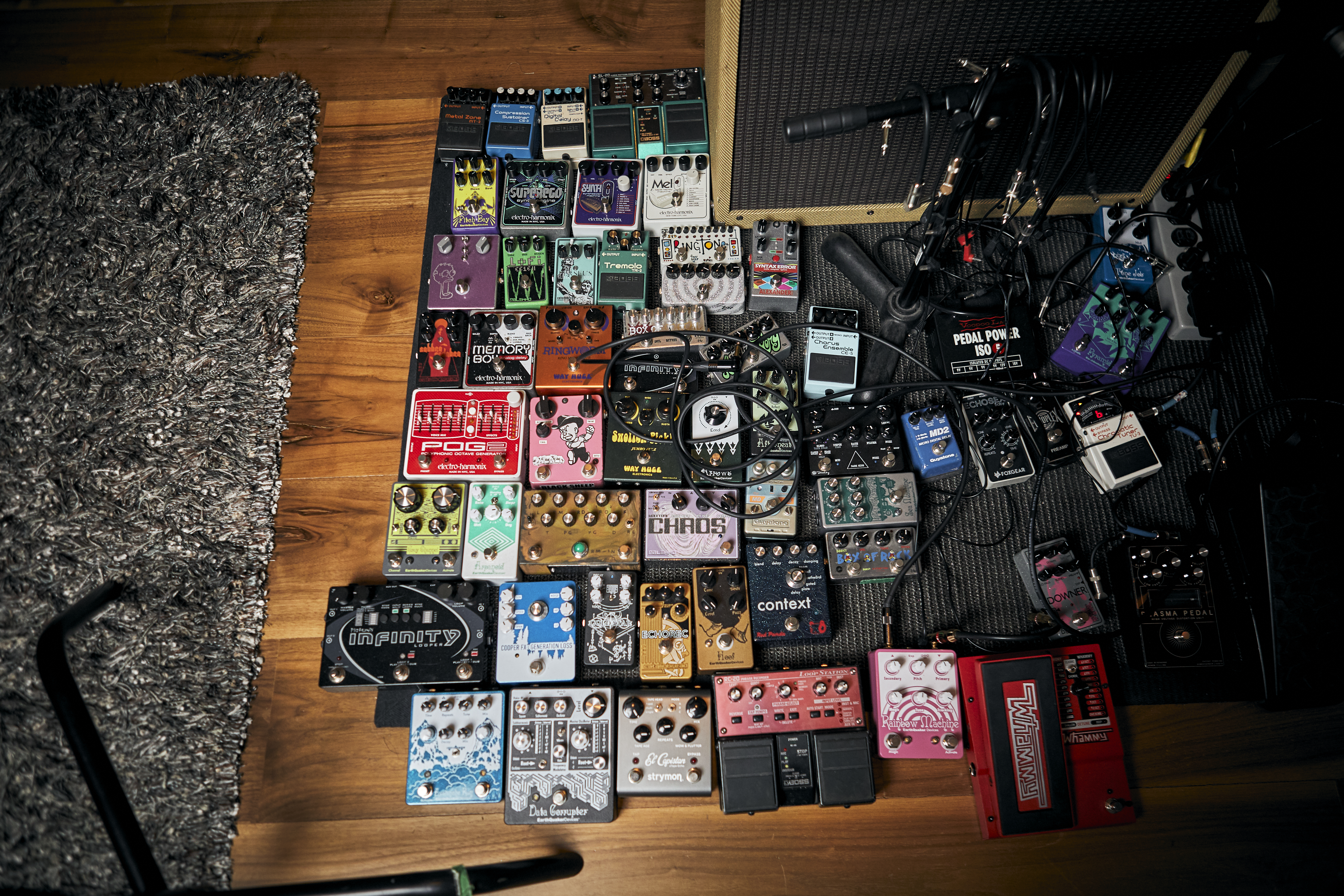
Some of what comes out with in that discomfort is based on a period when Bates and engineer Wolfgang Matthes studied auditory research conducted on live subjects by a German scientist back in 1969. It examined how conflicting frequencies would affect people emotionally and what impulses would fire in the brain.
“When you have tempos start to pull apart, you grow nervous, and it can be completely disconcerting,” Bates says, explaining how it increases your adrenalin and heart rate. In 2007, he scored the remake of John Carpenter’s horror flick Halloween and its sequel two years later.
Between 2007 and 2014, Bates worked on the hit TV show “Californication,” and in 2013 he began work on the Guardians of the Galaxy and John Wick franchises, both of which had 2014 release dates. Today Bates works primarily in Pro Tools, although he uses Logic and Cubase on the composition side, as well, along with samples from Vienna Symphonic Library.
On Guardians of the Galaxy, for some of the principal themes, director James Gunn had Bates compose the music first so he could shoot the scenes to the track, a process Gunn began on Rainn Wilson’s epilogue in the film Super.
“Rainn’s dialog served the purpose of a vocalist for me, and that’s the interesting thing about film,” Bates explains. “The dialog is the singer. So I would make a specific instrument choice for a scene with Chris Pratt as Peter Quill in Guardians of the Galaxy, as opposed to what instrument I would choose for Keanu Reeves as John Wick.
“In order to make the music not seem to fight his voice,” Bates continues, “I try not to use anything with sharp edges in the sound when there’s dialog with Keanu, as opposed to Chris Pratt, where I can definitely put some more aggressive midrange-driven percussion behind his voice and it won’t really interfere with his diction whatsoever.”
Speaking of John Wick, the song “Bullet Holes” from Bush’s forthcoming album ended up in the closing credits of the most recent installment. Because of the last-minute insanity of the film world, it ended up being a rough mix. Thankfully, Bates mixes while he goes along, but “the most important thing is the performance,” he reminds us.
He doesn’t use vocal booths; the vocalist is right there in the room with him. And he doesn’t like much in the way of effects while tracking. He used a Neumann M49 on Rossdale and a Manley Reference cardioid mic on everything he did with Marilyn Manson.
“I don’t compress on the way in because sometimes the music can be a bit dense, and with a compressed vocal it can be difficult to find a space later for it to sit organically in the song,” he says.
Another crazy time crunch on the recent blockbuster Fast & Furious Presents: Hobbs & Shaw presented Bates with the challenge of overdubbing 500 guitar tracks himself in two-and-a-half weeks, with the picture changing daily and in the midst of writing additional cues for the film. He describes that type of situation as “triage mode,” not suggesting that it’s disastrous, but that “it builds muscle.”
“That’s where this Kemper comes into play,” he notes. “I’ll find a sound that is going to be a medium sound for the action music, and probably record every guitar part in 4s. It’s very thick and it can at least cut through enough to not sound distracting. I don’t like the sound of thin guitars in a film score, so I have a tendency to just mult things a bunch so that they’ll not seem like they’re sticking out where they shouldn’t. That’s also tricky because it’s one thing to type crazy stuff into a computer on your keyboard with the help of MIDI and quantization and then have the best musicians in the world perform the orchestral score, but when you’re done and you have to match it, whether your reading chops are good or not, it’s still very difficult to do it on a guitar where that’s the call. That was the fun challenge in Hobbs & Shaw.
“You have to make considerations for all of those frequency ranges of the elements that are going to be featured in any frame of film,” he continues. “If you know there is an explosion happening or a gun that is going to be shot, you need to get out of the way of that frequency so you’re not going to be competing and you end up with sneakers in the dryer. I’m not a big fan of flamming.”
Bates seems to welcome the challenges, though. Currently he is psyched about the variety of projects on his plate, including music for the television shows “The Purge,” “Creepshow,” the animated show “Primal” (sans dialog), and the live-action show R.U.N. at the Luxor. He describes the Cirque Du Soleil show as “one made up of chapters.”
“Each of [the chapters] has a distinct approach,” Bates explains. “The score is oftentimes a hard-driving mash-up of rock and electro. There are ‘score’ moments, but the show is propulsive, to say the least. So don’t anticipate a tame musical score made up of studio musicians. This music is banging hard, from the moment the show begins. That said, there are deeply emotional moments in between, as well.”
The music is the first aspect of the show to be developed, and it plays a part in engaging all the creative talent on the show.
“Once a cue is in play, I then collaborate with all departments via the director, Michael Schwandt, to support the artistic objective of the lighting designer, the choreographer, and down the line,” Bates explains. “It’s a very intense process because it requires daily adjustments to tempos once we know the pacing of the performers’ movements when fighting or running, etc. I literally asked the choreographer to beat-box a voice memo to me to clearly illustrate rhythmic events he needed to support the dancers and trickers in a sequence of the show. Like stunt work, this is a true team effort.”
Bates thrives on the diversity of his work. What they all have in common is storytelling.
“I have loved the entire process of songwriting and recording since I first multitracked by daisy-chaining cassette recorders together in my bedroom when I was 14 years old,” he says. “I feel that making music in every medium inspires me to be creative always.”
Don’t be surprised if Bates adds performing again to his curriculum vitae. He actually toured with Manson on his 2015 “The Hell Not Hallelujah” tour, but this time it would be a return to his own entity, a la his first L.A. band, Pet, with the inclusion of edgy multimedia and sound.
One thing is certain: expect the unexpected and all envelopes pushed. Perhaps with a bit of discomfort.
